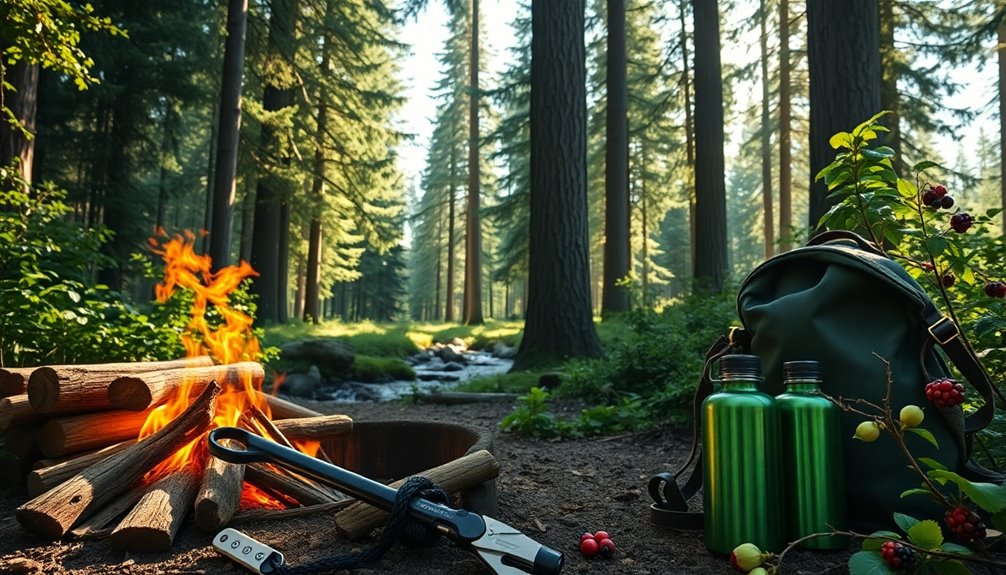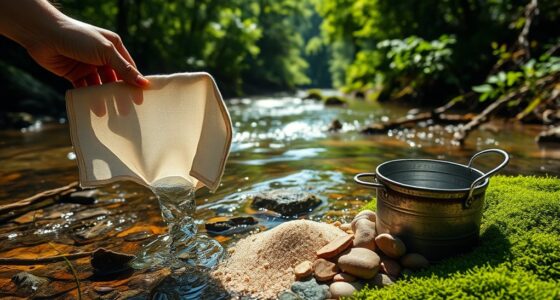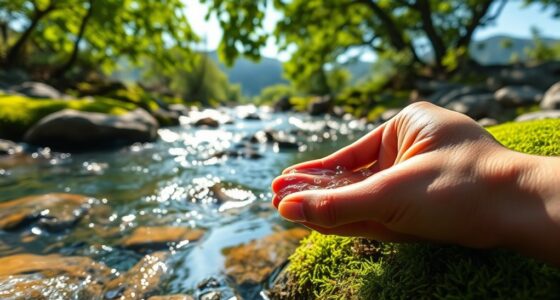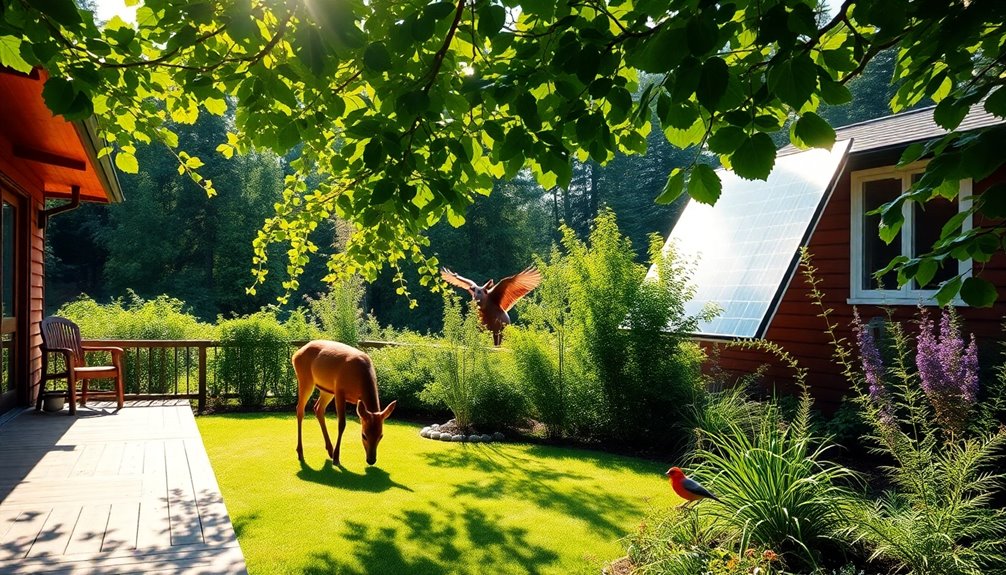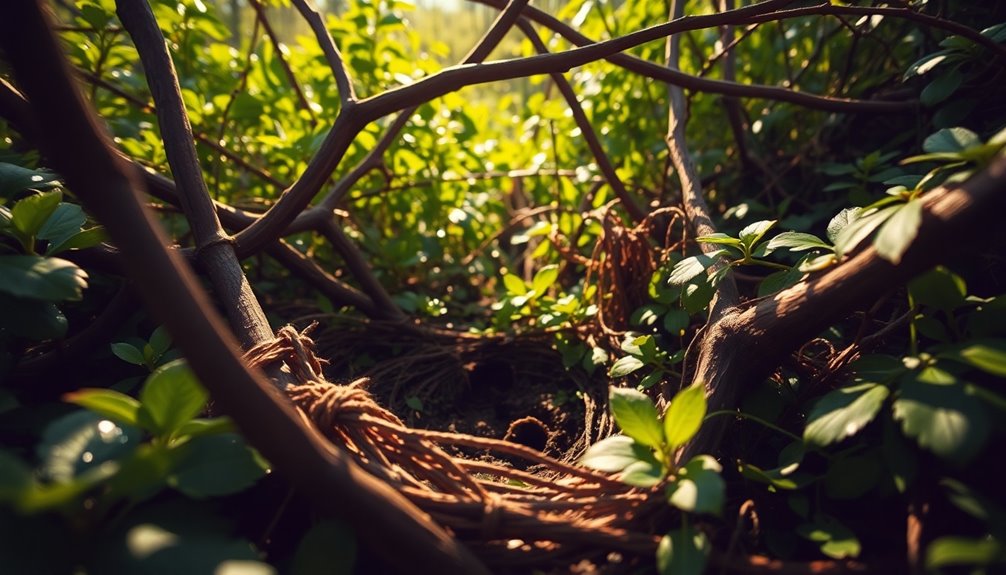To thrive in the wild, start by mastering navigation skills. Learn to read a map and use a compass; 70% of accidents are due to poor navigation. Build shelters with natural materials for protection, and identify safe water sources to stay hydrated. Fire-making techniques are crucial for warmth and signaling, while knowing edible plants ensures food security. First aid skills are vital for managing injuries. Maintain a positive mindset and have a clear survival plan. With these essentials covered, you're on your way to surviving the wilderness. Keep going to uncover even more tips and strategies for success.
Key Takeaways
- Master navigation skills using maps and compasses to avoid getting lost in the wilderness.
- Learn to identify and purify water sources, as survival without water is critical.
- Develop fire-making techniques for warmth, cooking, and signaling for help in emergencies.
- Build shelters from natural materials to protect against weather and retain body heat.
- Familiarize yourself with edible plants and basic trapping techniques for reliable food sources.
Introduction
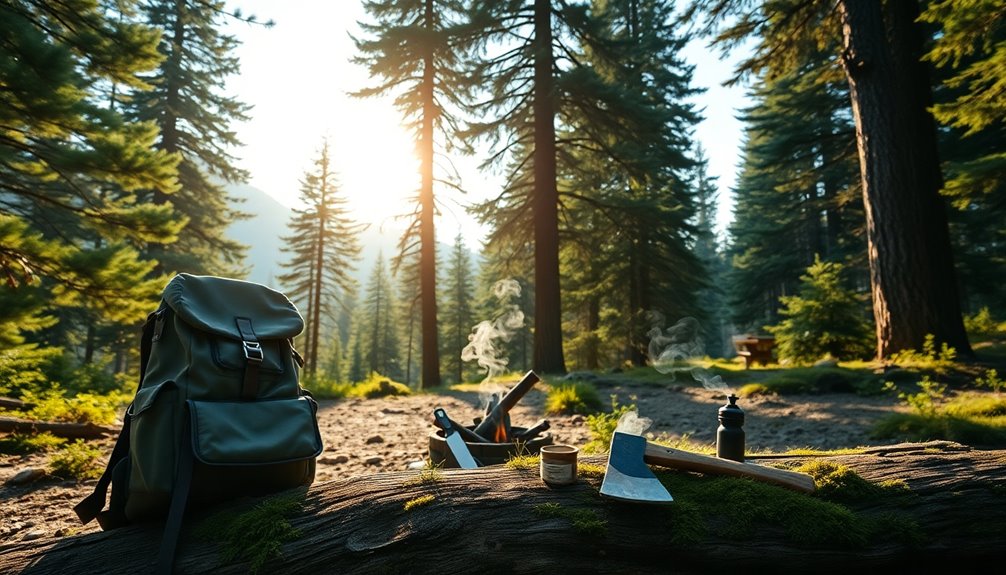
When you're out in the wilderness, having survival skills can make all the difference.
You need to prepare your mind and body for unexpected challenges, ensuring you're ready to tackle whatever comes your way.
Understanding these essentials won't only boost your confidence but also enhance your overall outdoor experience.
Survival Skills for Wilderness Adventures
Embarking on a wilderness adventure requires a solid foundation of survival skills to navigate the unpredictability of the great outdoors.
Start by mastering navigation skills, including map reading and compass use, to ensure you find your way.
Building a shelter helps protect you from harsh weather and retains body heat, crucial for survival.
Knowing how to identify and purify water sources is vital, as you can only survive a few days without water.
Firecraft skills provide warmth, cooking options, and a way to signal for help.
Familiarize yourself with edible plants to enhance food security.
Additionally, learn trapping and fishing techniques to secure meals and consider wilderness first aid to handle emergencies effectively.
Communication signals can also be lifesavers in critical situations.
Survival Mindset Essentials
Often, a strong survival mindset can be just as crucial as physical skills in the wilderness. By maintaining a positive mindset, you can enhance your decision-making and problem-solving abilities when faced with challenges.
Developing a clear survival plan helps you prioritize critical tasks like securing water, shelter, and warmth. Remember, feelings aren't facts; focus on actionable steps instead of panic.
Effective resource management, including an inventory of your supplies, bolsters your confidence and aids in planning. Cultivating mental resilience through techniques like visualization and stress management boosts your adaptability in tough situations.
Embrace these strategies to build a survival mindset that empowers you to thrive in the wild.
Survival Skill Overview
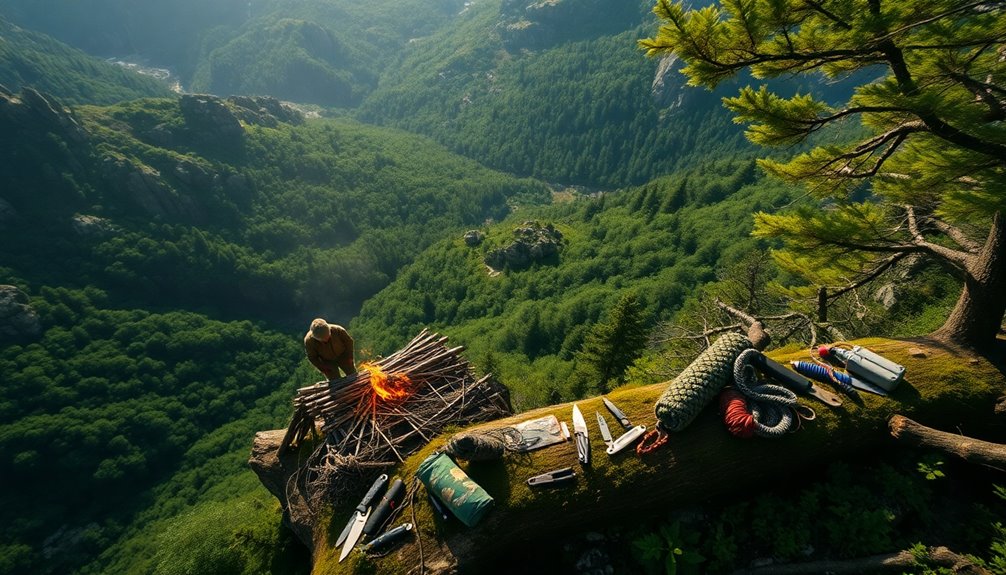
Mastering wilderness survival skills is essential for anyone venturing into the great outdoors. You need to focus on key areas like navigation, shelter building, fire making, and water procurement.
Effective navigation means understanding topographic maps and using a compass to stay oriented. For shelter, you must select the right site and use natural materials to protect yourself from the elements.
Fire is crucial for warmth and cooking; learn to create it using tinder and kindling. Don't forget about water—know how to source and purify it through boiling or filtration.
Lastly, be prepared for emergencies by practicing first aid and honing your food foraging skills. These essential tips will significantly boost your chances of thriving in wilderness survival situations.
Essential for Emergency Preparedness
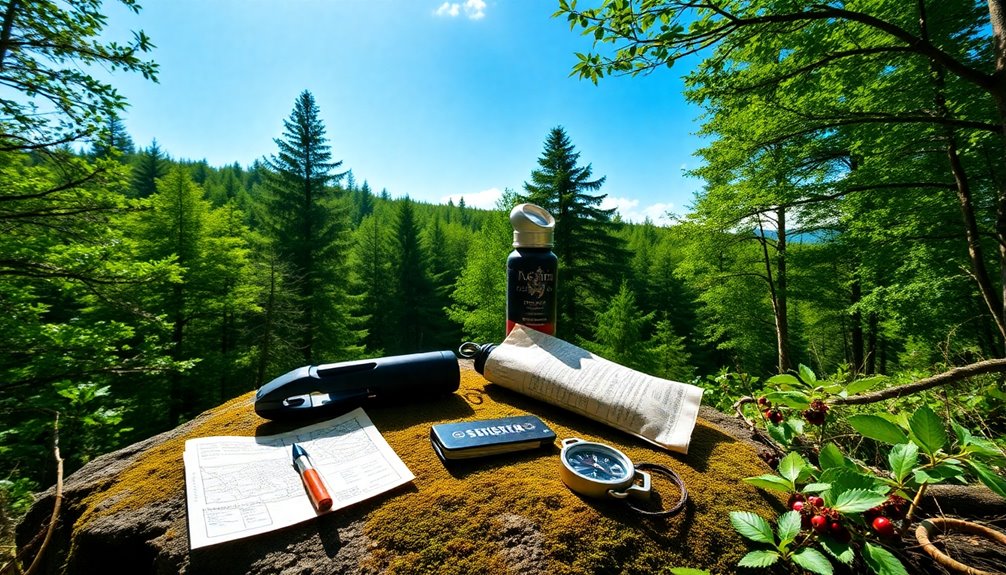
When you're in the wilderness, critical decisions can mean the difference between safety and danger.
Being aware of your surroundings and having a solid emergency plan is key to navigating unexpected situations.
Critical for Life-Saving Decisions
In wilderness survival, critical life-saving decisions often hinge on your preparedness for unexpected emergencies. To enhance your survival skills, develop a comprehensive emergency plan that includes escape routes and communication strategies.
Always carry a well-stocked first aid kit and practice basic first aid techniques, as these can be vital in managing injuries. Understanding the terrain helps you navigate effectively, while wildlife awareness minimizes risks from dangerous animals and poisonous plants.
Make sure to identify reliable water sources and know how to purify it for safe drinking water. Regularly practice these skills to build confidence and readiness for real-life scenarios, ensuring that you can respond effectively during crises and increase your chances of survival in the wild.
Contextual Awareness in Survival
Contextual awareness serves as a vital compass in wilderness survival, guiding your decisions and actions. By understanding your environment, you can identify potential hazards and make informed survival decisions. Familiarity with local flora and fauna helps you spot edible plants while avoiding poisonous ones, significantly boosting your survival chances.
Additionally, being aware of wildlife behavior and seasonal changes aids in anticipating resource availability, such as food and water sources. Recognizing signs of weather changes—like shifting winds or darkening clouds—allows you to prepare for storms and adverse conditions.
Lastly, situational awareness means continuously monitoring your surroundings for dangers, ensuring you're ready to respond effectively. Cultivating these skills is essential for thriving in the wild. Moreover, mastering the art of bug out bags can enhance your preparedness for unexpected situations.
Essential Gear for Survival
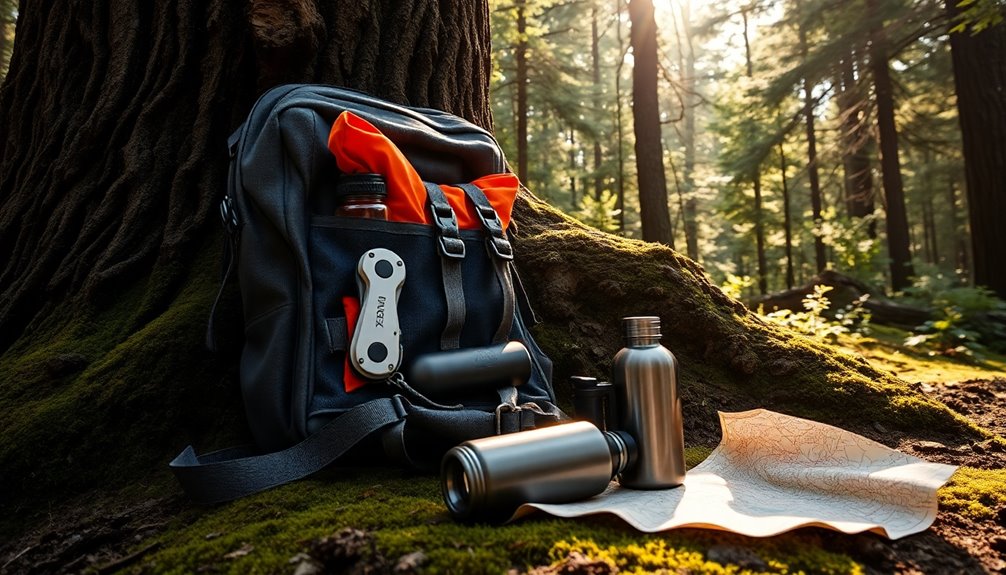
Having the right gear can make all the difference in a survival situation. A reliable lighter or waterproof matches are essential for quickly starting fires, providing warmth, cooking capabilities, and signaling for help.
Carrying a multi-tool enhances your versatility, allowing you to cut rope, prepare food, and build shelter efficiently. Access to safe drinking water is crucial, so a portable water purification system or hydration bag is a must.
An emergency blanket helps retain body heat, significantly increasing your chances of survival in cold conditions. Lastly, a well-stocked first aid kit is vital for treating injuries and preventing infections, containing supplies like adhesive bandages and antiseptic wipes.
Equip yourself wisely, and you'll be better prepared for the unexpected.
Survival Gear Recommendations
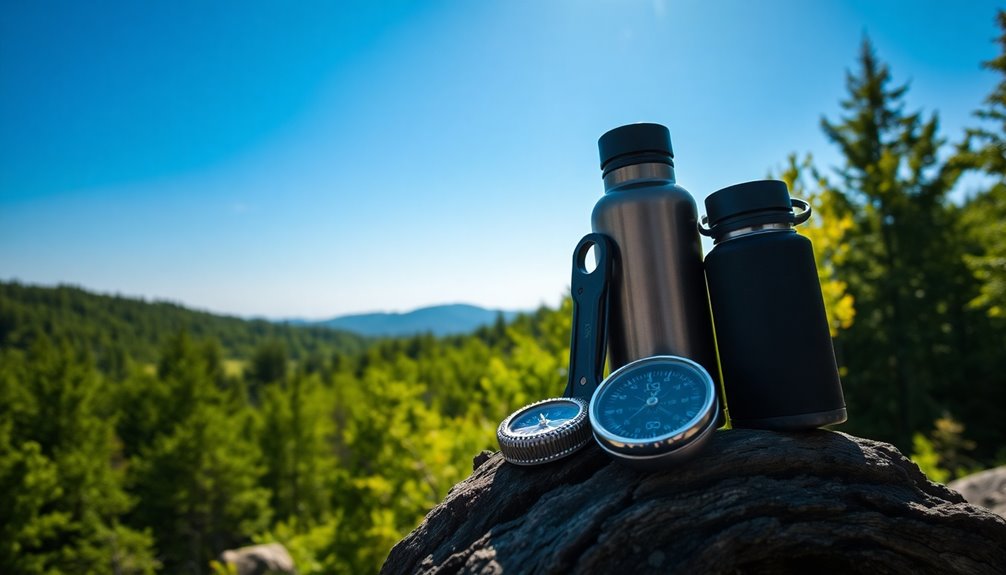
When venturing into the wilderness, it's crucial to choose the right survival gear to ensure your safety and comfort.
Start with a reliable multi-tool, like a Swiss Army knife, for tasks such as cutting and opening cans. Don't forget a lightweight, waterproof fire starter to ignite a fire in any weather.
A portable water filtration system, such as a Sawyer Mini, is essential for drinking safely from natural sources. Pack an emergency blanket to retain body heat in cold conditions, and use a weather-resistant backpack to keep everything organized and easily accessible.
Lastly, brush up on first aid skills and keep an eye on your surroundings to stay prepared for any challenges you might face.
Effective Gear Selection Techniques
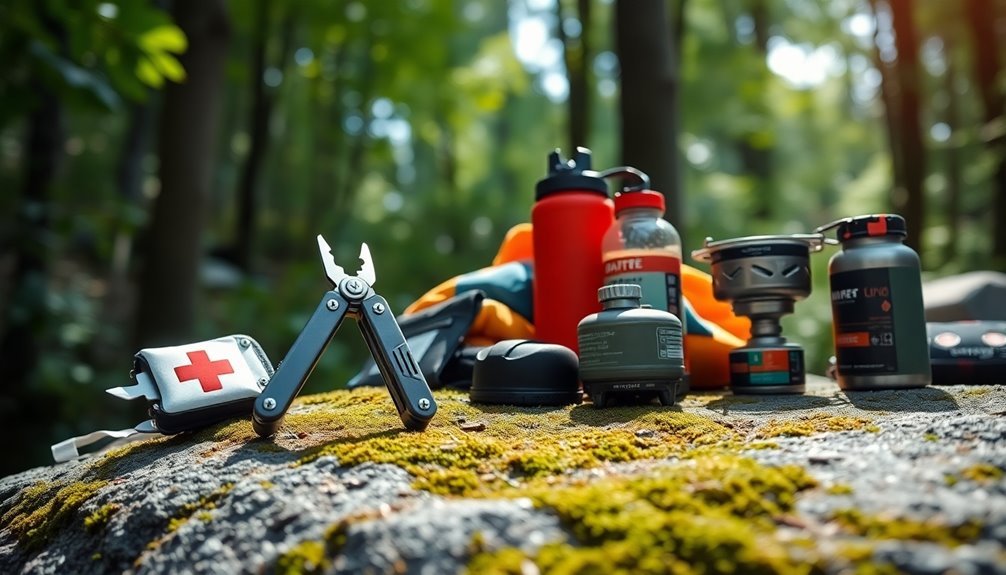
Choosing the right gear can make all the difference in a wilderness adventure. Focus on effective gear selection by prioritizing lightweight and multi-functional gear to minimize pack weight while maximizing utility.
Always go for weather-resistant clothing and gear to protect yourself against the elements, ensuring comfort in various conditions.
Invest in high-quality materials for essential items like knives, hydration bags, and emergency shelters, as their reliable performance is crucial in survival situations.
Regularly review and update your packing list based on your trip's specific environment and duration, ensuring you have all necessary gear without excess weight.
Lastly, familiarize yourself with the proper use and maintenance of each gear piece to guarantee optimal performance when you need it most. Additionally, ensure that your gear complies with safety standards to further enhance your protection and performance in the wild.
Navigating Unfamiliar Terrain Difficulties
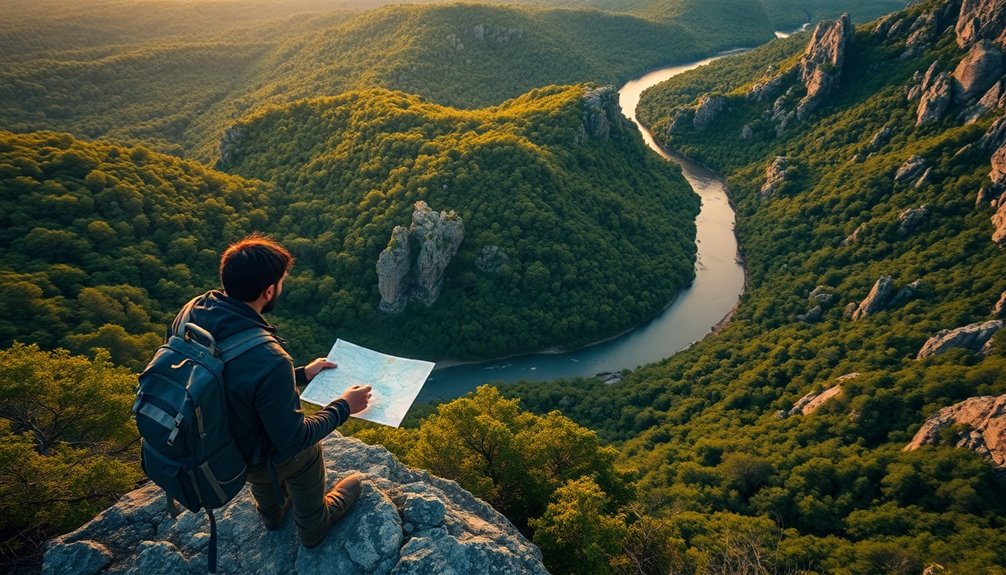
When you find yourself in unfamiliar terrain, having reliable navigation tools is essential for your safety.
It's not just about carrying a compass or GPS; you also need to know how to use them effectively.
Investing time in survival skills training can make a huge difference in your ability to navigate challenging landscapes.
Survival Skills Training Importance
Navigating unfamiliar terrain can throw even the most experienced adventurer off course, making survival skills training essential. With 70% of wilderness accidents stemming from poor navigation skills, mastering map and compass use is crucial.
Regular practice of orienteering techniques enhances your spatial awareness, helping you identify landmarks and plan effective routes. While GPS devices are handy, you must also know how to navigate without them; relying solely on technology can lead to challenges if batteries die or signals are lost.
Building navigation skills through consistent practice boosts your confidence in the wild, enabling you to respond to unexpected wildlife encounters and adapt to changing conditions.
Use Reliable Navigation Tools
Mastering navigation skills doesn't just rely on knowledge; it also requires the right tools in your kit. Always carry a reliable compass to determine your direction, especially when visibility is poor or GPS signals fail.
Familiarize yourself with topographic maps, as they provide crucial details about elevation, terrain, and landmarks in unfamiliar areas. Before venturing out, practice using your GPS device to ensure you can input coordinates and track your location accurately.
Learn triangulation techniques using visible landmarks on your map to confirm your position in dense forests or rugged terrain. Regularly check for natural navigation cues, like the sun's position or water flow, to maintain direction without solely relying on technology.
Stay prepared and navigate confidently!
Survival Stories From Experienced Adventurers
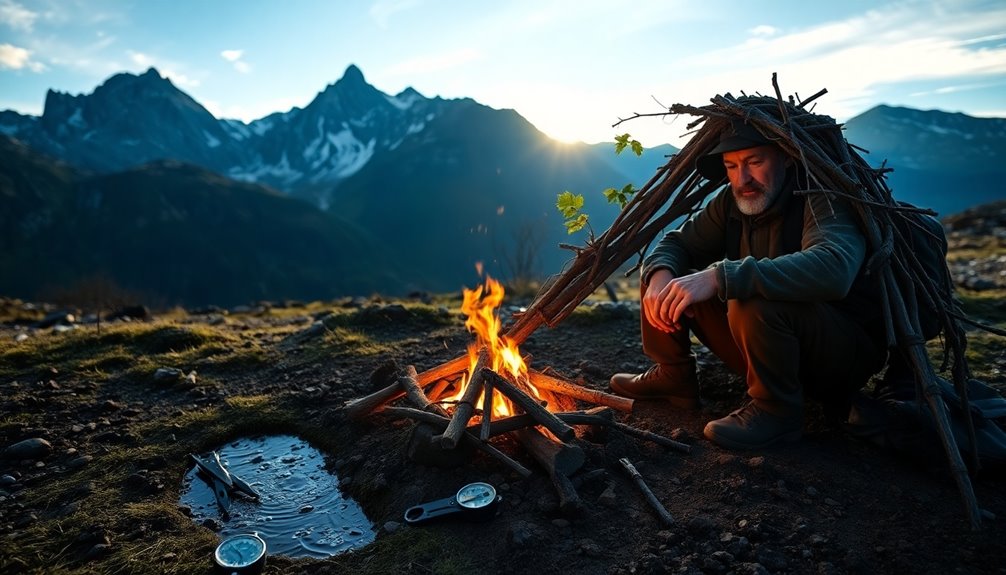
Survival stories from experienced adventurers often reveal invaluable lessons learned in the wild. Many recount survival situations where mastering navigation skills proved crucial for finding their way back to safety.
They emphasize the value of preparation, noting that learning basic trapping and identifying edible plants secured food during tough times. Fire-making techniques not only provided warmth but also served as a vital signaling method for rescue.
Using water filters became essential for drinking safely. Adventurers often highlight how constructing a shelter protected them from harsh elements.
Ultimately, mental resilience and adaptability emerged as key themes, as maintaining a positive mindset empowered them to face challenges with valuable skills and confidence. Additionally, understanding natural signs can enhance your ability to forecast weather changes while in the wilderness.
These stories can inspire your own wilderness survival journey.
Conclusion
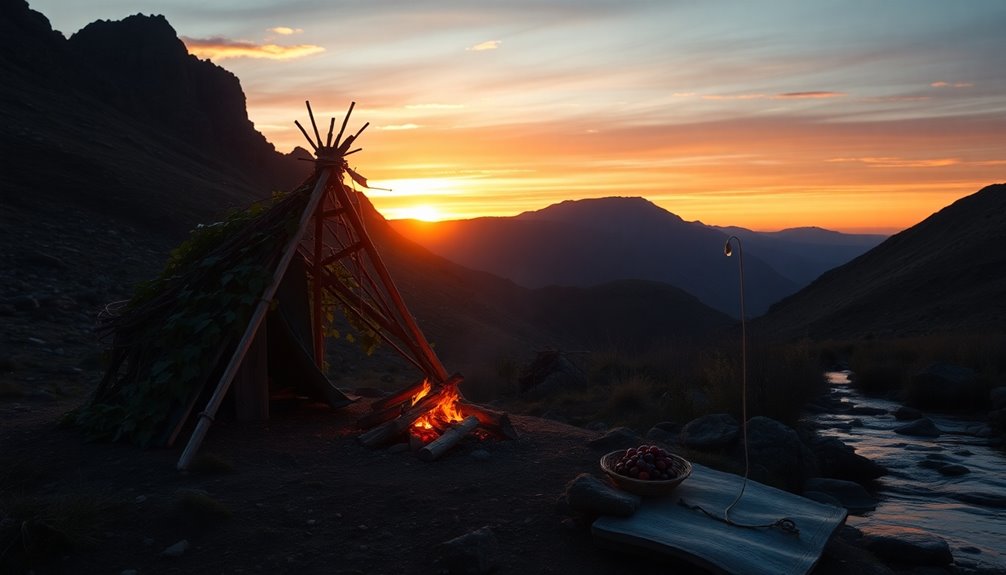
The lessons learned from experienced adventurers highlight the importance of wilderness survival skills in ensuring safety and well-being in the wild.
Mastering survival tips every person should know, like making fire and water to a rolling boil for purification, is crucial. You'll want to learn how to identify local wildlife and the edible parts of plants to avoid attracting danger.
Additionally, understanding essential first aid techniques and taking a basic first aid course can save lives in emergencies. Remember to properly clean and dress wounds to prevent infection.
Developing mental resilience and adaptability will help you remain calm during crises. Regular practice and continuous learning of these essential skills will prepare you for unexpected challenges in the wilderness.
Additional Resources
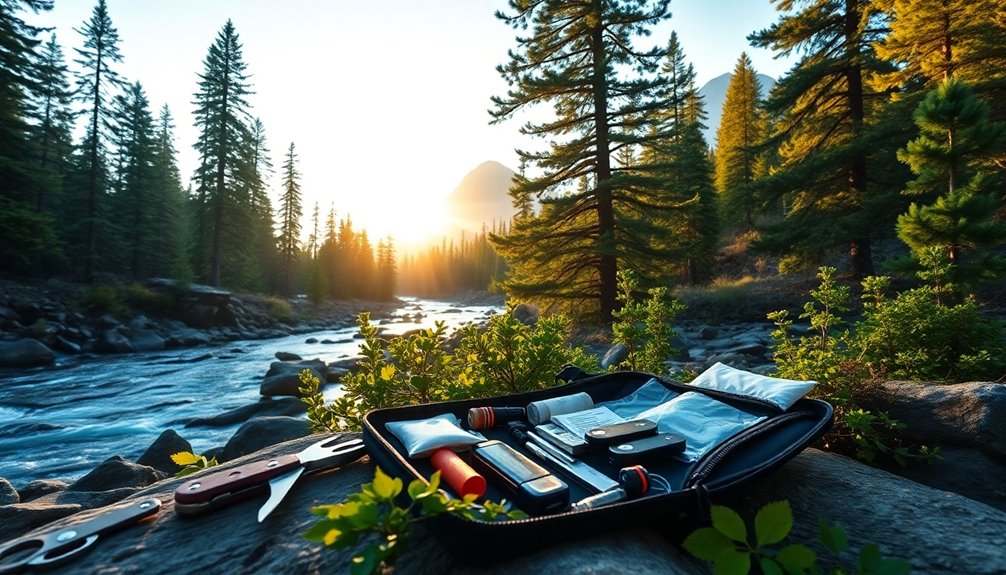
Access to quality resources can significantly enhance your wilderness survival skills.
Consider enrolling in a first aid course, focusing on wilderness first aid training to learn how to clean and dress wounds effectively. Look for local experts who can provide hands-on training in essential skills like shelter building and fire starting.
Additionally, explore online resources, such as the Wilderness Survival subreddit, where you can find valuable tips on learning food sources in the wilderness. Watch instructional videos on platforms like YouTube to visually grasp vital techniques.
Lastly, join outdoor clubs that offer community events, allowing you to practice your skills in a supportive environment. These resources will prepare you to thrive in any wilderness situation. Regular outings to parks can also help build confidence and adaptability in various environments.
Frequently Asked Questions
What Are the 10 Essential Survival Items?
When you think about essential survival items, consider a reliable multi-tool for various tasks, a portable water purification system for safe drinking water, and a durable fire starter to create warmth and cook food.
You'll also need a compact emergency shelter for protection from the elements, and a comprehensive first aid kit for any injuries.
Don't forget items like a signaling device, extra clothing, food supplies, a flashlight, and a whistle for emergencies.
What Are the 5 C's of Survival?
The 5 C's of survival are critical for thriving in challenging environments.
You need Cutting Tools, like knives, for tasks such as food prep and shelter building.
Combustion Devices, including fire starters, are essential for warmth and cooking.
Cover provides shelter against the elements, while Containers help you carry and purify water.
Lastly, Cordage is vital for securing gear and constructing shelters.
Mastering these elements can significantly increase your chances of survival.
What Is the 3-3-3 Rule for Survival?
The 3-3-3 Rule for survival outlines your immediate priorities in a crisis.
You can survive three minutes without air, so securing breathable air is crucial.
Next, you'll need shelter, as you can only last three hours without it in extreme conditions.
After that, focus on finding clean water, which you can go without for three days.
Food is the least urgent; you can manage without it for up to three weeks.
Prioritize wisely!
What Are the 7 Priorities of Wilderness Survival?
When you think about the seven priorities of wilderness survival, remember the "survival rule of threes."
First, ensure your air supply is secure.
Then, find or create shelter to protect against the elements.
After that, focus on obtaining water, as hydration's vital.
Finally, while food is least urgent, start foraging for safe plants or hunting if necessary.
Prioritize these steps to enhance your chances of survival in the wild.

